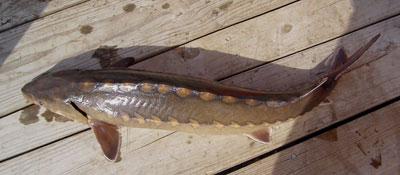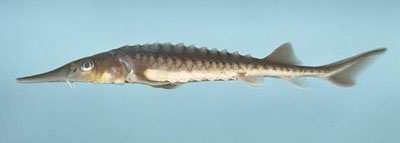From St. John's River in Florida to St. John River in New Brunswick, this globally rare fish has many aliases - little sturgeon, salmon sturgeon, softshell, pinkster, roundnoser, bottlenose or mammose. Whatever you call it, the Shortnose Sturgeon is one of the oldest, most primitive species of bony fish on earth. Maryland's largest freshwater fish has likely been swimming around for millions of years; sturgeon cousins of this species have left behind fossils dating to 150 million years ago.
Shortnose Sturgeons, along with their larger cousins Atlantic Sturgeons, have been an important part of human history on the Chesapeake for thousands of years. Native Americans utilized these fish for meat. The skin may be worked into leather. The first "cash crop" sent back to Europe from the Jamestown settlement was sturgeon meat and caviar.

Shortnose Sturgeons are bony fishes, without scales. Their body surface is covered with five rows of plates or scutes. They have blunt noses when they are adults (brevirostrum = Latin for short snout) although the snouts are more elongated in juveniles. This feature contributes to misidentification of younger fish as Atlantic Sturgeon. The Shortnose is the smaller of the two sturgeon species found in the Bay, attaining a maximum length of "only" 4.5 feet and weighing in at 50 pounds. The Atlantic Sturgeon, by comparison, can reach lengths of 15 feet and tip the scales at 800 pounds. Interestingly, Shortnose Sturgeon will grow faster in the southern populations (North Carolina and southward) but reach larger sizes in the northern populations (Connecticut and points north). The Shortnose is considered a long-lived fish; the males seldom live to 30 years but the oldest females can survive into their 60s.

The sturgeon mouth is on the bottom of the head which helps, as they are bottom feeders. Four whicker-like barbels near the mouth act as sensors. Juveniles dine on benthic, or aquatic bottom dwelling insects, and crustaceans. Adults enjoy a diet of mollusks and crustaceans. Sturgeons have no teeth; they suck their food in and digest it in a gizzard-like organ (similar to one found in birds).
For at least 70 million years, Shortnose Sturgeon have been found in the Bay. Sturgeons are anadromous fish, meaning they spend most of their life in the Bay (or the slower waters of the lower river reaches) and migrate upstream to fast moving cooler waters to spawn. Shortnose Sturgeon rarely leave their own river system and don't inhabit open ocean areas, although they may be found infrequently in nearshore marine habitats. There are 19 individual populations of Shortnose Sturgeons within their total range, each in its own river system (the Chesapeake Bay population includes the Potomac River). Populations are managed separately because it is unlikely that they would ever intermix, due to geographic separation.
The Shortnose Sturgeon was first listed as Federally Endangered in 1967, under the Endangered Species Preservation Act (the precursor to the 1973 Endangered Species Act). (Its listing classmates include the recently delisted Bald eagle.) The reasons for this species' endangered status are many. All stem from its vulnerability to habitat changes during is its life cycle. It breeds slowly, lives long, and has specific habitat requirements for different parts of its life.
The decline started back in the 1800's. Sturgeon, as the source of caviar, were highly valued by commercial fishermen. Although the Shortnose was not the target species, it was caught incidentally in the fishing of Atlantic sturgeon and in the gill nets used to catch alewife and shad. In 1890, the Chesapeake Bay was the second largest caviar fishery, at 700,000 pounds processed per year. To add insult to injury, many dams were built in the 1800's and early 1900's, effectively cutting off the sturgeon from some spawning grounds and altering the conditions of others.
The habitat of the Bay continued to degrade as developmental and industrial pressures on shorelines affected both the fish and their prey species. Industrial discharge, agricultural run-off, dredging and disposal of shipping channels resulted in the alteration and loss of marshes and mudflats which are the primary habitat for non-breeding sturgeon and their favored mollusks and crustaceans. These activities also affect levels of dissolved oxygen in the water, which has detrimental effects on many aquatic species, both plant and animal.
These animals reach breeding age slowly; Chesapeake females first spawn around 11 years of age. They also don't spawn every year so the population is not rapidly replaced. Thus, they take a long time to recover from population declines. Because they live so long sturgeon can also suffer from bio-accumulation of toxins and heavy metals found in the water and in the foods they eat.
In 1998, a recovery plan was put in place to be administered by the National Marine Fisheries Service (NMFS). The plan identifies threats to this species and outlines actions that should be taken to help the Shortnose Sturgeon return to healthy population levels. Conveniently, these actions will also support additional species which are considered valuable and necessary to the health of the Bay, species like rockfish, blue crabs, oysters, shad and various species of waterfowl. Recovery actions address water quality issues and habitat alteration, access to quality spawning streams, incidental take from legal fishing and poaching, and methods to boost the population with stocking.
Additionally, the US Fish and Wildlife Service (USFWS), NMFS and MD Department of Natural Resources are asking for help from the fishing community. If you catch a live sturgeon (Shortnose or Atlantic), please contact USFWS at 1-800-448-8322. Researchers will weigh, measure and tag live specimens before releasing them back into the Bay.
The plight of the Shortnose Sturgeon in the Chesapeake Bay in not unique, nor are the measures we can take to help it back to health. Improving water quality, understanding the value of a wetlands and shorelines, recognizing the need to maintain or restore natural systems has benefits for all of us who depend upon the Bay for our livelihoods and our lives.
- Photographs courtesy of Noel Burkhead (juvenile); USFWS, Ian Park and Brian Richardson (adults)
